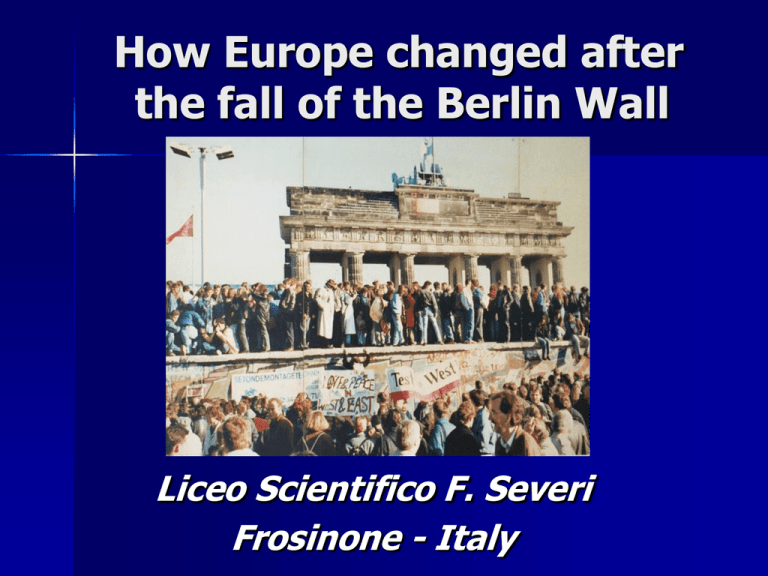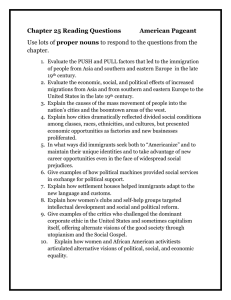The fall of the Berlin Wall
advertisement

How Europe changed after the fall of the Berlin Wall Liceo Scientifico F. Severi Frosinone - Italy For 28 years from 1961 to 1989 the Berlin wall divided the city and Germany into two parts. It was the symbol of the division of Europe into two blocks and the landmark of the Cold War. The “ Iron Curtain” has divided Europe for 50 years “From Stettin in the Baltic to Trieste in the Adriatic an "Iron Curtain" has descended across the continent. Behind that line lie all the capitals of the ancient states of Central and Eastern Europe. Warsaw, Berlin, Prague, Vienna, Budapest, Belgrade, Bucharest and Sofia; all these famous cities and the populations around them lie in what I must call the Soviet sphere, and all are subject, in one form or another, not only to Soviet influence but to a very high and in some cases increasing measure of control from Moscow “ (W. Churchill, March 3rd, 1946) Military alliances The clash also becomes military (there are two blocks): In 1949 the NATO was created, also including USA, Canada, Great Britain, France, Benelux, Danemark, Iceland, Italy, Portugal and Norway. In 1955 the Warsaw’s Pact was estabilished (USSR, Czechoslovakia, Bulgary, Hungary, Poland, Romania, Albania…) The cold war From 1947 to 1989 the world lives a peaceful period but peace is constantly threatened by a total war and it is interrupted by local crises. The two blocks The two Germanies In 1949 in Western Germany the Federal Republic of Germany was founded , joining the NATO pact. In Eastern Germany the Democratic Republic of Germany was born , joining the Warsaw’s Pact. In 1961 the Berlin wall was built, dividing the city into two parts: east and west . How Germany and Berlin were divided The rise of the wall (1961) The Wall in front of the Brandeburg Gate (1961) The first “cracks” of the Berlin wall The Hungarian Revolution in 1956 The Prague Spring in 1968 The movement of “Solidarnosc” led by Lech Walesa in Poland in 1980 Growing protest movements in the countries of Eastern Europe. The turning point of the 1980s At the end of the 1980s contradictions in the communist regimes of Eastern Europe emerged : Failure of the collectivistic economy Failure of the “People’s Republics”, without consensus, and led by repressive governments After 1985, the soviet leader Mikhail Gorbaciov made democratic reforms in USSR: “perestroika” and “glasnost”. This favoured the birth of the revolutions in 1989 in the countries of Eastern Europe and finally the collapse of the USSR in 1991. 1989: The Fall of the Berlin Wall In 1989 Eastern German citizens started a peaceful protest in the name of freedom, democracy and human rights. On 9th November 1989 the Berlin wall was torn down and in 1990 East and West Germany were unified. Today, they are all European citizens EUROPE AFTER THE FALL OF THE BERLIN WALL Effects of the Fall of the Berlin Wall The fall of the Berlin Wall has been one of the most important step in the process of birth of the present European Union. The European Union aimed at the cooperation among states and at the creation of a single currency. The European Union ensures all its citizens four fundamental freedoms: free movement of goods, services, capital and people. Thanks to the Schengen Agreement of 1995, EU citizens can travel freely in the EU countries. After the opening of the borders, a huge wave of migration started, from Eastern Europe to the Western countries. People wanted to improve their quality of life or escape from war and persecution. Since then, all the countries of the E.U. and have attracted a large numbers of immigrants, also in Italy, especially from Eastern European Countries . Why do people emigrate? Macro-social reasons: economic causes, war, persecution, discrimination Meso-social reasons: social and civil networks as a resource. Micro-social reasons: family reunions, individual life plans Characteristics of the new migration Acceleration : People move quickly Diversification: People come from different countries Globalization : People move all over the world Feminization : women are a large part of migrants Types of migrants Working immigrants Seasonal or contract immigrants Skilled immigrants Accompanying family members Refugees and asylum seekers Illegal immigrants Second Generation Immigrants Return Immigrants Unfortunately migrations have caused new inequalities: poverty injustice crime work problems school integration problems access to public services Areas of inequality Income distribution Risk of poverty Fewer professional chances Risk of unemployement Risk of becoming ill and not receiving the right treatment Housing conditions School performances Fewer chances of social mobility Foreign immigration in Italy There are 4.919.000 immigrants, about the 8% of the resident population According to the research “Transatlantic Trends” (2013), Italians think immigrants are about 23% of the resident population A fourth of the immigrants resident in Italy live in Lombardia (23,8%), Veneto, Lazio (11,3%) and Emilia Romagna (10,9%). The only provinces of Rome and Milano host 400.000 immigrants each. Children born in foreign families were 77.000 in 2013, i.e. the 13% of total births in Italy (24% in Veneto and in Lombardia) Where immigrants come from The largest foreign community comes from Romania (now EU country ) with 21% of all foreigners present on Italian territory, followed by Albania (non-EU country ) ( 10, 6%) and Morocco ( non EU country (9,9%). Many foreign citizens from the eastern countries of the European Union have high education level , but most of them are employed in agriculture…… ……..domestic help …….seasonal jobs ………and building Immigrants’ Children attend Italian Schools. School is the place where a real process of integration starts . Economy and the world of work In 2013 regular immigrants contributed to 11,1% for italian’s PIL They gave to State 10.827 billions of euros and they received 9,95 billions of euros for welfare The monthly wage in 2012 was of 971 euros for foreign people and 1.258 euros for Italian people. Critical Aspects of the Italian Situation Spontaneous arrival and settlement from extra European countries Refugees from Somalia, Eritrea, Nigeria , Pakistan and Afghanistan Temporary stay in CIE ( integration and expulsion centres) before moving to other countries Inadequate institutional regulation Welcoming contrasted by a part of the civil society Limits to the citizenship Social and Political issues Frequent changes in the Politics of Integration Failure in political planning concerning immigration Security problems which prevent a real immigrants’ integration Uncontrolled waves of immigration Difference between foreign official residents and real presence of immigrants The Italian immigration policy has always fluctuated between permissiveness and extemporary limitations In a period of severe economic crisis , uncontrolled immigration can increase social tensions in those areas where the presence of immigrants is great . It would be wrong to raise a new “Berlin Wall”, but at the same time it ‘s difficult to open the doors of our territory without controls, without resources, without adequate laws and aids that could insert immigration issues in a whole European project of welcoming and integration .






